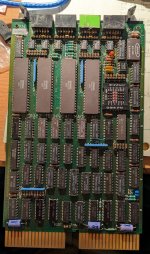jmdhuse
Experienced Member
Hello All,
I got my hands on what looks like a clone of the M8043 quad serial channel module. It is manufactured by "Technical Magic Inc." and uses the same IM6042 UARTs as the actual M8043 board. Unfortunately, I cannot find any documentation about the many jumper options and so I don't know how to configure or test it. Does anyone have any information about this board?
Thanks, Jon.
Here's a snapshot:

I got my hands on what looks like a clone of the M8043 quad serial channel module. It is manufactured by "Technical Magic Inc." and uses the same IM6042 UARTs as the actual M8043 board. Unfortunately, I cannot find any documentation about the many jumper options and so I don't know how to configure or test it. Does anyone have any information about this board?
Thanks, Jon.
Here's a snapshot:

